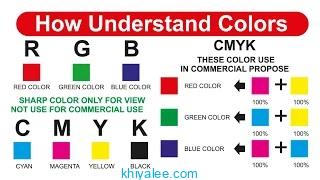How to Understand Basic Colors in Graphics
Are you a graphic designer struggling to understand the difference between CMYK and RGB color modes? This video is for you! In this comprehensive guide, we’ll explain the science behind colors and provide tips and tricks to help you master the basics of color theory. You’ll learn how to choose the right color palette for your designs and create perfect color combinations using CMYK and RGB. Watch this video now to take your graphic design skills to the next level!
A Beginner’s Guide to Understanding Basic Colors in Graphics: From RGB to CMYK
Introduction to Color Theory
Color theory is an essential component of graphic design that helps artists and designers understand how colors interact, convey emotions, and affect viewer perceptions. This guide aims to provide a comprehensive overview of basic colors in graphics, focusing on two primary color models: RGB and CMYK. Understanding these models is crucial for anyone involved in digital design or print media.
As we delve into the intricacies of color theory, we will explore the significance of color in graphics, the mechanics of RGB and CMYK, the importance of the color wheel, and common mistakes to avoid. This exploration will equip you with the knowledge needed to make informed choices in your design projects.
Understanding RGB: The Digital Color Model
What is RGB?
RGB stands for Red, Green, and Blue, the three primary colors used in digital graphics. This color model is additive, meaning that colors are created by combining light rather than pigments. When red, green, and blue light are mixed in varying intensities, they produce a wide array of colors. For instance, combining all three colors at full intensity yields white light, while their absence results in black.
How RGB Works
The RGB model operates on a scale from 0 to 255 for each color component, allowing for over 16 million possible color combinations. This flexibility is particularly advantageous in digital environments such as monitors, televisions, and web design. Each pixel on a screen uses RGB values to display color, making it vital for designers to understand how to manipulate these values effectively.
Applications of RGB in Digital Graphics
RGB is predominantly used for digital displays and online content. Graphic designers utilize this model when creating images for websites, social media, and digital advertisements. The vibrant colors produced by the RGB model make it ideal for capturing audience attention on screens. Moreover, software tools like Adobe Photoshop and Illustrator rely heavily on this color model for designing graphics.
Exploring CMYK: The Print Color Model
What is CMYK?
CMYK stands for Cyan, Magenta, Yellow, and Key (Black), and is the primary color model used in color printing. Unlike RGB, CMYK is a subtractive color model, meaning that colors are created by subtracting varying percentages of light absorbed by inks. In this model, combining all four colors produces a darker color, often black, which is why the term Key refers to the black ink used in printing.
How CMYK Differs from RGB
The most significant difference between RGB and CMYK lies in their applications. While RGB is designed for digital displays, CMYK is tailored for print. The transition from RGB to CMYK can sometimes lead to color discrepancies, as certain vibrant colors displayed on screens cannot be replicated in print. Therefore, understanding the limitations and capabilities of each model is essential for designers working across both media.
Applications of CMYK in Print Media
CMYK is primarily used in printing processes, such as brochures, magazines, and posters. Graphic designers often prepare their files in CMYK mode to ensure that the printed output matches their digital designs as closely as possible. Printing houses and publishers rely on this color model to achieve accurate color reproduction in physical media.
How to Understand Basic Colors in Graphics
The Color Wheel and Its Significance
The color wheel is a visual representation of color relationships and is fundamental in understanding color theory. It typically consists of 12 colors: three primary colors (red, blue, yellow), three secondary colors (green, orange, purple), and six tertiary colors (mixes of primary and secondary colors). The arrangement of colors on the wheel helps in finding harmonious color combinations.
Primary, Secondary, and Tertiary Colors
Primary colors are the building blocks of all other colors and cannot be created by mixing other colors. Secondary colors are formed by mixing two primary colors, while tertiary colors are produced by mixing a primary color with a secondary color. Understanding these categories aids designers in creating visually appealing compositions.
Complementary and Analogous Colors
Complementary colors are those that are opposite each other on the color wheel, such as blue and orange. They create a striking contrast when used together, making designs pop. On the other hand, analogous colors are adjacent to each other on the wheel, like blue, blue-green, and green. This combination creates a harmonious and cohesive look, often used in branding and marketing materials.
Choosing the Right Color Model for Your Project
When to Use RGB
RGB is the go-to color model for any project destined for digital screens. If your work involves creating graphics for websites, apps, or digital marketing, using RGB ensures that your designs are vibrant and eye-catching. This model allows for a wide range of color variations, making it suitable for high-resolution displays.
When to Use CMYK
Conversely, CMYK should be used for any print-related projects. When preparing designs for brochures, business cards, or posters, converting your colors to CMYK from the outset is crucial. This prevents unexpected color shifts during the printing process and ensures that the final output closely matches your digital design.
Factors Influencing Your Choice
Several factors can influence your choice between RGB and CMYK. The medium of your final product, the required color accuracy, and the audience’s viewing context should all be considered. For example, if your audience is primarily viewing your work online, RGB is the optimal choice. However, if your design will be printed, CMYK becomes essential.
Common Mistakes to Avoid
Neglecting Color Profiles
One common mistake is neglecting to use color profiles, which can lead to discrepancies between what is seen on the screen and what is printed. Each device has its unique way of interpreting colors, and failing to manage these profiles can result in unexpected outcomes. Always ensure that the color settings are appropriate for the color model you are using.
Ignoring Color Contrast
Another common error is ignoring color contrast, which is crucial for readability and visual interest. Designers should ensure that there is sufficient contrast between colors, especially when using text over background colors. Poor contrast can lead to a design that is hard to navigate or understand, undermining the entire purpose of the graphic.
Misunderstanding Color Formats
Misunderstanding color formats is another frequent pitfall. Designers must familiarize themselves with various formats, such as HEX, HSL, and others, that are pertinent to both digital and print media. Knowing when to use each format is crucial for maintaining color integrity across different applications.
Conclusion
Recap of Key Takeaways
In summary, understanding color theory, particularly the RGB and CMYK color models, is essential for anyone involved in graphic design. The RGB model is optimized for digital media, while CMYK is tailored for print. By understanding the color wheel, the significance of primary, secondary, and tertiary colors, and the best practices for choosing color models, designers can create effective and visually appealing graphics.
Encouragement for Further Exploration of Color in Graphics
As you continue your journey in graphic design, consider experimenting with different color combinations and learning more about advanced color theory concepts. The world of colors is vast and offers endless possibilities for creativity and expression.
FAQs
1. Why is color theory important in graphic design?
Color theory is essential in graphic design as it helps designers understand how colors affect emotions and perceptions, ensuring effective communication through visual elements.
2. Can I use RGB for print designs?
Using RGB for print designs is not recommended as it can lead to color discrepancies. Always convert to CMYK for print projects to ensure color accuracy.
3. What are the primary colors?
The primary colors are red, blue, and yellow. These colors cannot be created by mixing other colors.
4. How do complementary colors work?
Complementary colors are opposite each other on the color wheel and create a strong contrast when used together, enhancing visual appeal.
5. What should I consider when choosing a color model?
Consider the medium of your output (digital or print), the required color accuracy, and the context in which your audience will view your work.
 My Account
My Account 




Your article gave me a lot of inspiration, I hope you can explain your point of view in more detail, because I have some doubts, thank you.